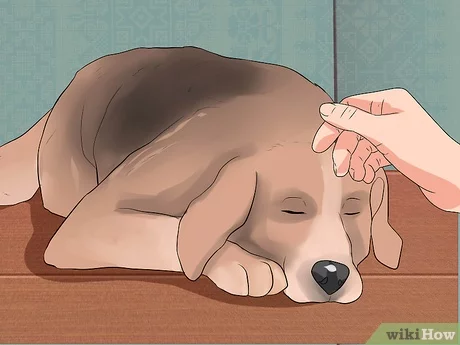Why Does My Dog Sit On My Lap
Why Does My Dog Sit on My Lap? The Surprising Science and Psychology Behind This Cute Behavior
If you’re a dog owner, chances are you’ve experienced the joy (and sometimes annoyance) of having your furry friend plop down on your lap. Whether you’re watching TV, reading a book, or working on your laptop, your dog seems to think that your lap is the best seat in the house. But why does your dog do this? Is it just because they love you, or is there something else going on?
In this article, we’ll explore the possible reasons why dogs sit on laps, from an evolutionary and behavioral perspective. We’ll also look at some common myths and misconceptions about lap-sitting, and give you some tips on how to manage this behavior if it becomes too much for you.
The Evolution of Lap-Sitting: From Wolves to Pets
To understand why dogs sit on laps, we need to go back in time to their wild ancestors: wolves. Wolves are pack animals that live in social groups called packs, where hierarchy and cooperation are essential for survival. When a pack hunts or travels together, they often rest in a pile or circle, with the dominant individuals taking the center spots and the subordinate ones staying on the edges.
This pattern of physical closeness and touch has been observed in many other mammal species, including primates, elephants, and dolphins. It seems to serve several functions, such as thermoregulation (sharing body heat), bonding (reducing stress and promoting trust), and communication (conveying emotions and intentions through touch).
When humans started domesticating wolves thousands of years ago, they selected for traits that made them more sociable and trainable. Over time, these wolves evolved into dogs, which became increasingly dependent on human contact and affection. As dogs adapted to living with humans, they learned to read our body language and emotions, and to respond to our cues and commands. They also developed new behaviors, such as tail wagging, eye contact, and licking, that are specific to their interactions with humans.
One of these behaviors is lap-sitting. Dogs seem to enjoy being close to us, both physically and emotionally. Sitting on a lap allows them to feel safe, warm, and loved, while also giving them a better view of their surroundings and access to social interaction. Lap-sitting may also serve as a way for dogs to assert dominance or claim territory (i.e., your lap is their spot), but this is less common than the affectionate motive.
The Science and Psychology of Lap-Sitting: A Look at the Research
While anecdotal evidence and personal experience suggest that lap-sitting is a positive behavior for both dogs and humans, there hasn’t been much scientific research on this topic. However, some studies have explored related aspects of dog-human interaction that shed light on the mechanisms behind lap-sitting.
For example, a study published in the journal PLOS ONE in 2015 found that gazing into a dog’s eyes can trigger the release of oxytocin in both the human and the dog’s brain. Oxytocin is a hormone that plays a key role in social bonding, trust-building, and stress reduction. When you look into your dog’s eyes while they’re sitting on your lap, you may be activating this neurochemical pathway that reinforces your emotional connection.
Another study published in the journal Applied Animal Behaviour Science in 2012 examined how different types of physical contact affect dogs’ behavior towards their owners. The researchers observed that dogs who received more petting and stroking from their owners were more likely to solicit attention from them later on. This suggests that physical touch can reinforce social bonds between dogs and humans, and increase mutual affection.
A third study published in the journal Anthrozo?s in 2008 investigated the effects of petting and talking to dogs on their behavior during veterinary exams. The researchers found that dogs who received more petting and talking from their owners were less anxious and fearful during the exams, and had lower levels of stress hormones in their blood. This suggests that physical touch and vocal communication can have a calming effect on dogs, and help them cope with stressful situations.
All these studies support the idea that lap-sitting is a natural and beneficial behavior for dogs, as long as it’s done in a positive and respectful way. Dogs who sit on laps may be seeking comfort, reassurance, or attention from their owners, and they may also be expressing their affection and loyalty. Humans who allow dogs to sit on their laps may experience similar benefits, such as reduced stress, increased happiness, and improved social connection.
Myths and Misconceptions About Lap-Sitting: Separating Fact from Fiction
Despite the many benefits of lap-sitting for dogs and humans, there are some myths and misconceptions about this behavior that need to be addressed. Here are some common ones:
– Myth #1: Lap-sitting is only for small dogs or lapdogs.
Fact: While it’s true that some dog breeds are more likely to enjoy sitting on laps than others (such as Chihuahuas, Maltese, or Pomeranians), any size or breed of dog can learn to appreciate lap time if they’re comfortable with their owner and trained properly. Even large breeds like Great Danes or Mastiffs can be lapdogs if they want to be!
– Myth #2: Lap-sitting is always a sign of dominance or aggression.
Fact: While it’s possible for dogs to use lap-sitting as a way to assert themselves over their owners or other pets (especially if they’re not getting enough exercise or stimulation), this is not the norm. Most lap-sitting dogs do it out of affection and trust, not dominance or aggression. If your dog seems to be growling, snapping, or guarding their lap space aggressively, you may need to address some underlying behavior issues with the help of a professional trainer or veterinarian.
– Myth #3: Lap-sitting is always appropriate and cute.
Fact: While lap-sitting can be adorable and endearing, there are times when it may not be appropriate or safe. For example, if you’re driving a car, cooking on a stove, or using sharp tools, having a dog sit on your lap could distract you or cause an accident. Also, if your dog has medical conditions that make them uncomfortable or in pain when sitting in certain positions (such as arthritis, hip dysplasia, or spinal problems), you should avoid letting them sit on your lap for extended periods of time. Always use common sense and good judgment when deciding whether to allow your dog to sit on your lap.
Tips for Managing Lap-Sitting Behavior: How to Keep Your Dog Happy and Healthy
If you’re struggling with your dog’s lap-sitting behavior (either because it’s too much for you or because your dog is too demanding), here are some tips that may help:
– Set boundaries: Teach your dog that sitting on your lap is a privilege, not a right. Encourage them to sit next to you or on their own bed instead of always seeking your lap. Use positive reinforcement (such as treats, praise, or toys) to reward them when they follow your commands and respect your personal space.
– Provide alternatives: Give your dog other activities and outlets for their energy and attention. Play with them, take them for walks or runs, give them puzzle toys or chew toys to keep them occupied. This will reduce their dependence on lap-sitting as the only source of stimulation.
– Train basic commands: Teach your dog basic obedience commands such as “sit,” “stay,” “come,” and “off.” This will help them understand what you expect from them and how to behave in different situations. Use positive reinforcement and consistency to reinforce these commands.
– Consult a professional: If your dog’s lap-sitting behavior is causing problems for you or for them (such as separation anxiety, aggression, or excessive barking), consider consulting a professional trainer or behaviorist. They can help you identify the root causes of the behavior and design a personalized training plan to address it effectively.
Conclusion
In summary, lap-sitting is a cute and natural behavior that dogs may exhibit as a way to express their affection and seek comfort from their owners. While there are some myths and misconceptions about this behavior, most lap-sitting dogs do it out of love, not dominance or aggression. By understanding the science and psychology behind lap-sitting, as well as using some simple tips for managing this behavior, you can enjoy this special bond with your furry friend without any negative consequences. So go ahead, let your dog sit on your lap (if they want to), and enjoy the warm fuzzies that come with it!



